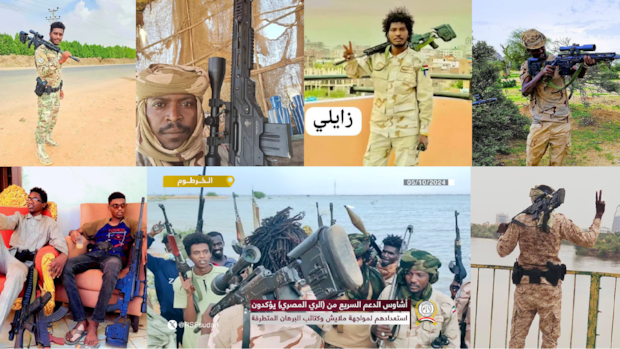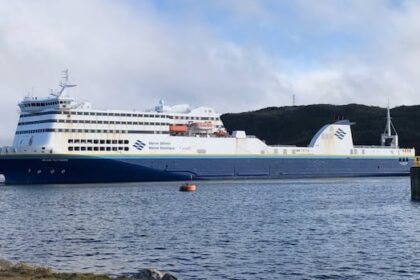Weapons bearing the logo of a Canadian arms manufacturer have been identified in the hands of a paramilitary group in Sudan responsible for massacres of civilians, analysis by CBC’s visual investigations unit has found. The civil war that erupted on April 15, 2023, has wreaked havoc on civilian infrastructure, decimated health-care facilities in Sudan and resulted in the world’s largest humanitarian crisis. An estimated 150,000 people have died in the conflict and more than 12 million civilians are internally displaced. The city of El Fasher — considered the last stronghold of the Sudanese Armed Forces (SAF) in Darfur — has become the epicentre of Sudan’s spiralling war. For more than 500 days, the city had been under siege, encircled entirely by the Rapid Support Forces (RSF), which experts have accused of ethnic cleansing. On Oct. 26, the city finally fell to the RSF. Reports of civilian massacres followed. Multiple photos posted online and verified by CBC show rifles with the logo of Sterling Cross Defense Systems, an Abbotsford, B.C.-based company that produces firearms and ammunition, in the hands of RSF fighters.Images shared on social media by RSF fighters — noted over the years by research groups such as War Noir and Streaking Delilah, and verified by CBC — depict Sterling Cross’s XLCR sniper rifles in the hands of fighters throughout Sudan since at least 2023. The CBC visual investigations team verified the images by either geolocating them in Sudan or matching emblems and camo designs to those used in Sudan. CBC also confirmed the design of the Sterling Cross XLCR, which features a distinctive logo on the rifle’s lower receiver, just above the magazine well.On Oct. 5, 2024, as the battle for Sudan’s capital, Khartoum, was unfolding, the RSF posted a video on its official Telegram channel showcasing its fighters along the city’s southern front line.Slung over the shoulder of one RSF fighter in the video is a modern-looking, bolt-action precision rifle, with a skeletonized folding stock, a handguard and a high-power scope. Then, for just a few frames as the fighter turns his back to the camera, a small emblem becomes visible on the rifle’s chassis: the Sterling Cross logo. A still from a video published by the RSF shows a fighter holding a rifle with the logo of Sterling Cross Defense Systems. (RSFSudan/Telegram, Sterlingcrossdefense/Facebook)This is not a one-off appearance of the weapon in Sudan. With the help of international open-source intelligence researchers, CBC’s visual investigations team has verified at least nine photos or videos with rifles bearing the Sterling Cross logo.If you have a tip for the CBC News visual investigations team, email: vi@cbc.ca.Another undated image posted on Instagram shows an RSF fighter, clad in desert camouflage, standing on a road. On his shoulder, he holds the same Sterling Cross rifle, with the company logo visible. An image shared on social media shows a Sudanese fighter wearing an RSF uniform holding a rifle. An image of Sterling Cross’s XLCR rifle is shown on the right for comparison. (Streakingdelilah/Instagram, Sterlingcrossdefense/Instagram)Sterling Cross When reached for comment, Sterling Cross would not answer specific questions about CBC’s findings in Sudan, its current international arms sale business — which would fall under the purview of Global Affairs Canada — and whether it has sold weapons to countries that are alleged to supply factions in Sudan, including the United Arab Emirates. “I can assure you that Sterling Cross’ policies align with that of Global Affairs Canada,” Aimee Byrne, Sterling Cross’s director of operations, said in a statement, adding the company is subject to the Export and Import Permits Act.Global Affairs Canada did not respond to CBC’s request for comment in time for publication. Sterling Cross’s website is bare bones, made up of nothing more than two buttons to contact the company’s defence and logistics arms.The small firm was established in 2008, according to incorporation documents seen by CBC, and is based out of a plaza in Abbotsford that also hosts welding and industrial supply businesses.CEO Tim McFarlane told B.C. outlet The Province in 2013 that the company operated as a broker for international militaries at the beginning. “We would source product worldwide for different military agencies, then we would broker the deal, not unlike a real estate broker,” he said.A 2019 photo shared by Sterling Cross on social media displays dozens of rifles and is captioned, “XLCR final inspection before delivery !!” (Sterlingcrossdefense/Instagram)According to the article, Sterling Cross opened its commercial arm in 2011, producing rifles and ammunition and advertising to Canadian hunters. But it maintained business connections abroad, including in the Middle East.“We’re a one-kit global solution,” MacFarlane said. “We brand, we broker, we source, we manufacture.”Sterling Cross has had contracts with the Canadian government in the past. One contract, ending in 2017, saw the company deliver ammunition to the Department of National Defence for $189,422. Another contract, also from 2017, states that the logistics side of the firm delivered $24,818 worth of goods under the Canadian commodity code for calculating machines.A contract shows that the Department of National Defence awarded Sterling Cross $189,422 to deliver ammunition between 2014 and 2017. (Department of National Defence)Sterling Cross has produced the XLCR rifle since at least 2019. In an Instagram post, the company published an image showing at least 77 rifles captioned “XLCR final inspection before delivery !!”All these rifles feature the same company logo, located in the same spot as on rifles seen in Sudan.According to a 2020 Facebook post, the company was also running tests with the rifle, stating, “New product testing coming along nicely #xlcr #excelsior #ballistics #rangetesting.” That post featured another photo of a rifle with the company logo in the same spot as on the rifles spotted in Sudan.International brokersKholood Khair, director of the Khartoum-based think-tank Confluence Advisory, said the proliferation of foreign weapons in Sudan’s conflict has contributed to prolonging the war. In addition to the appearance of Turkish and Iranian drones, “we have seen reports of American, British and Canadian spare parts or full weapons making their way into RSF hands through the U.A.E.,” she said.Canada has maintained an arms embargo on Sudan since 2004 as well as material and financial sanctions against entities and individuals implicated in the conflict since 2024. It’s unclear how the Sterling Cross-branded weapons made their way into Sudan. But experts told CBC countries such as the United Arab Emirates have rerouted Canadian equipment in the past. “Canada exports millions of dollars’ worth of weapons and systems to the U.A.E., which supplies the RSF,” said Emadeddin Badi, a Toronto-based senior fellow at the Global Initiative Against Transnational Organized Crime. “The U.A.E. does not have a domestic defence industry of its own robust enough to supply multiple paramilitary groups across the region.”Armoured vehicles produced by Canadian firm Streit Group and outfitted with machine guns have been pictured carrying RSF fighters in Sudan for more than a decade. In 2016, a UN report accused Streit Group and the U.A.E. of brokering sales. However, Streit opened a factory in the U.A.E. in 2012, and there were no rules regulating the flow of weapons if they were not produced in Canada. In 2019, Canada joined the international Arms Trade Treaty and implemented legislation that requires Canadian citizens to obtain a permit to export arms from one country to another and take action against international brokers. According to Badi, under the new legislation, Canadian firms found to be in violation could face prosecution in Canada. WATCH | The significance of the fall of El Fasher in Sudan:What the fall of Sudan’s El Fasher means for the warA two and a half year war between rival warlords in Sudan has taken another catastrophic turn with the capture of El Fasher in the Darfur region by Rapid Support Forces. For The National, CBC’s Chris Brown breaks down what happened and why the UN is calling it the world’s worst humanitarian disaster.The United Arab Emirates has been accused of providing arms to the Rapid Support Forces by U.S. intelligence agencies and human rights groups, although it has repeatedly denied sending weapons. The SAF is reportedly backed most prominently by Egypt, Turkey and Iran. Chinese arms have also been spotted on both sides of the battlefield.On Sunday, the U.A.E.’s senior diplomatic adviser Anwar Gargash signalled the country may be distancing itself from the conflict. “We all made a mistake when the two generals who are fighting the civil war today overthrew the civilian government,” said Gargash. “That was, looking back, a critical mistake. We should have put our foot down collectively. We did not call it a coup.”‘Canada needs to do better’ According to Badi, Canada’s public-facing system for tracing arms exports has a number of structural gaps. He said it has strict licensing rules on paper, but that it’s “weak” on monitoring weapons once they’ve left the country. “And when it relies on brokers to conduct the transfers, then the end-use chain becomes opaque,” he said.CBC consulted ImportGenius, a global trade data platform, to find records of exports between Canada, the U.A.E. and Sudan. No detailed records could be uncovered.“Canada doesn’t publicly release granular trade data, unlike the United States and other countries,” said Mike Kanko, CEO of ImportGenius. “Public awareness of corporate activity is essential in an informed society. Visibility for all stakeholders keeps companies accountable, and consumers safe.”Granular trade data would identify companies involved in shipping activity, and is distinct from statistical trade data that aggregates shipments by product category, he said. “Canadians … need to have a much better sense of their tracking and monitoring mechanism to know where weapons are ending up,” said Khair. “That is a huge part of accountability.”Nicholas Coughlin, Canada’s former envoy in South Sudan, told CBC that mechanisms in Canadian law can address the issue. “For example, under the Export and Imports Permit Act, Canada might place the U.A.E. on the Country Control List, or it could impose re-export conditions on it through the Broker Control List,” he said. Badi said “Canada needs to do better.”“This isn’t to say there aren’t legal mechanisms, but ultimately with the way the U.A.E. funnels its support — mostly through shell companies registered in foreign jurisdictions — it’s going to be a game of Whac-a-Mole.”
Sudanese fighters accused of massacres use rifles made by B.C. company











